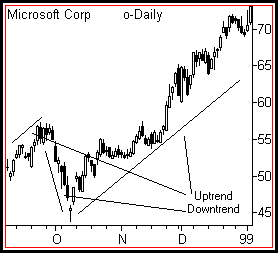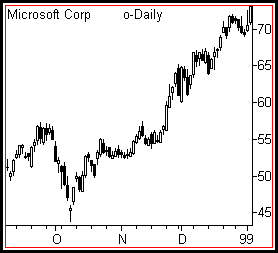A friend recently introduced me to the stock market. She told me that anybody make money from it by understanding how to use a technical analysis of stocks. Technical Analysis is defined as:
…a method of evaluating future stock prices and market directions based on statistical analysis of variables such as trading volume, price changes, etc., to identify patterns.
Basically you need to know math and pattern recognition. There is another way of looking at stocks called the fundamental analysis, which is:
Research and examination of a corporation’s financial statements and balance sheets to predict the future price movements of their securities. Among other indicators, fundamental analysts study past records of assets, earnings, sales, products, management and markets to predict future trends.
My friend, however, likes math and prefers to use the technical analysis. She gave me a brief lecture on how it worked.
Essentially, she told me to look at patterns like these:
She explained that I can get these charts by gathering data from the stock market. Each company has a public listing and all information about its shares of stocks are listed there. When I subscribe to a stock broker system (various websites exist), I could download this information and use computer software to plot out the data.
Each individual equity, market and index listed on a public exchange has a chart that illustrates this movement of price over time. This is what’s called the stock chart.
Individual data plots for charts can be made using the CLOSING price for each day. The plots are connected together in a single line, creating the graph. Also, a combination of the OPENING, CLOSING, HIGH and/or LOW prices for that market session can be used for the data plots. This second type of data is called a PRICE BAR. Individual price bars are then overlaid onto the graph, creating a dense visual display of stock movement.
By plotting the data this way, trends can be identified. By looking at upward and downward trends, people can decide when to buy.

I was told that if I see the upward pattern emerge, I should consider buying the stock. A stock in an uptrend will continue to rise until some change in value or conditions occurs. Declining stocks will continue to fall until some change in value or conditions occurs.
Chart readers try to locate TOPS and BOTTOMS on the chart, which are those points where a rally or a decline ends. Taking a position near a top or a bottom can be very profitable.
My friend says that Technical Stock Analysis is great because the same general principles can be applied to different markets – including bonds and even foreign currency exchange.
Being a math enthusiast, I found my friend’s explanation quite interesting. This got me so interested that I’m planning to attend a short seminar on technical stock analysis.
If you have some extra money, you might want to consider looking at this too.
